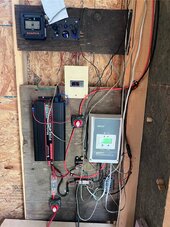a system I set up over a year ago with help from this forum has been powering a small freezer without issue…until last week. After losing a bunch of food, I discovered the freezer, a small 3 cu ft model wasn’t reaching 0.
I purchased a new freezer in a panic only to discover that the old one worked when plugged into the house (grid) socket and the new one also struggles to get to zero, now hovering around 11.
The freezer is plugged into a Novopal 2000w inverter with an inkbird wired into it. The inkbird is supposed to turn on the inverter only when the freezer needs to turn on.
I am not sure what the problem could be as all the components seem to be working. Where should I begin to test things? Thank you!
I purchased a new freezer in a panic only to discover that the old one worked when plugged into the house (grid) socket and the new one also struggles to get to zero, now hovering around 11.
The freezer is plugged into a Novopal 2000w inverter with an inkbird wired into it. The inkbird is supposed to turn on the inverter only when the freezer needs to turn on.
I am not sure what the problem could be as all the components seem to be working. Where should I begin to test things? Thank you!




